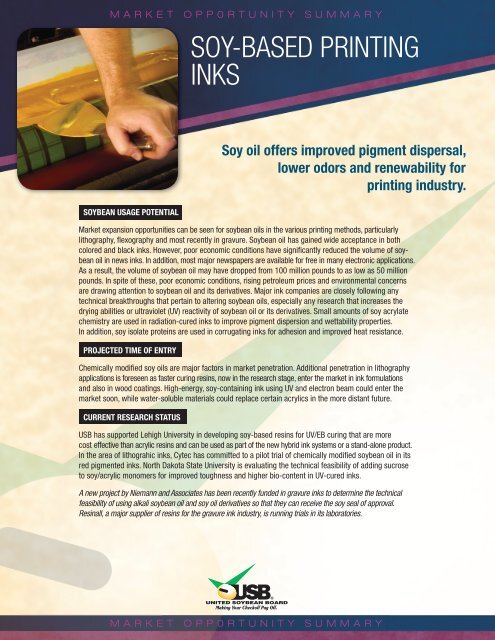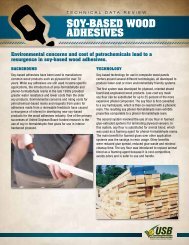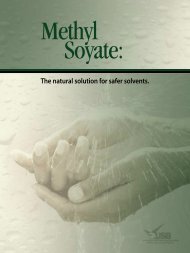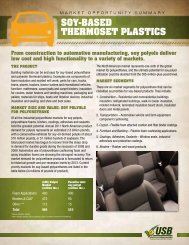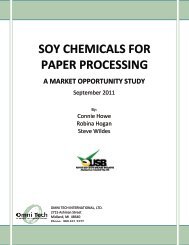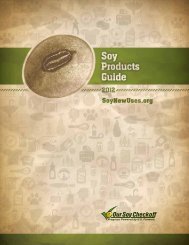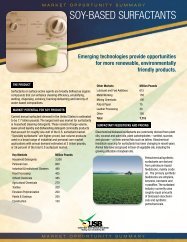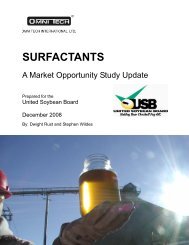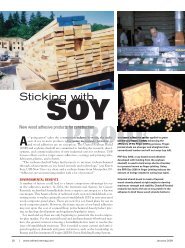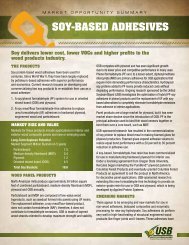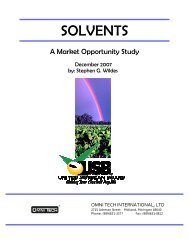SOY-BASED PRINTING INKS - Soy New Uses
SOY-BASED PRINTING INKS - Soy New Uses
SOY-BASED PRINTING INKS - Soy New Uses
You also want an ePaper? Increase the reach of your titles
YUMPU automatically turns print PDFs into web optimized ePapers that Google loves.
MARKET OPP0RTUNITY SUMMARY<br />
<strong>SOY</strong>-<strong>BASED</strong> <strong>PRINTING</strong><br />
<strong>INKS</strong><br />
<strong>SOY</strong>BEAN USAGE POTENTIAL<br />
<strong>Soy</strong> oil offers improved pigment dispersal,<br />
lower odors and renewability for<br />
printing industry.<br />
Market expansion opportunities can be seen for soybean oils in the various printing methods, particularly<br />
lithography, fl exography and most recently in gravure. <strong>Soy</strong>bean oil has gained wide acceptance in both<br />
colored and black inks. However, poor economic conditions have signifi cantly reduced the volume of soybean<br />
oil in news inks. In addition, most major newspapers are available for free in many electronic applications.<br />
As a result, the volume of soybean oil may have dropped from 100 million pounds to as low as 50 million<br />
pounds. In spite of these, poor economic conditions, rising petroleum prices and environmental concerns<br />
are drawing attention to soybean oil and its derivatives. Major ink companies are closely following any<br />
technical breakthroughs that pertain to altering soybean oils, especially any research that increases the<br />
drying abilities or ultraviolet (UV) reactivity of soybean oil or its derivatives. Small amounts of soy acrylate<br />
chemistry are used in radiation-cured inks to improve pigment dispersion and wettability properties.<br />
In addition, soy isolate proteins are used in corrugating inks for adhesion and improved heat resistance.<br />
PROJECTED TIME OF ENTRY<br />
Chemically modifi ed soy oils are major factors in market penetration. Additional penetration in lithography<br />
applications is foreseen as faster curing resins, now in the research stage, enter the market in ink formulations<br />
and also in wood coatings. High-energy, soy-containing ink using UV and electron beam could enter the<br />
market soon, while water-soluble materials could replace certain acrylics in the more distant future.<br />
CURRENT RESEARCH STATUS<br />
USB has supported Lehigh University in developing soy-based resins for UV/EB curing that are more<br />
cost effective than acrylic resins and can be used as part of the new hybrid ink systems or a stand-alone product.<br />
In the area of lithograhic inks, Cytec has committed to a pilot trial of chemically modifi ed soybean oil in its<br />
red pigmented inks. North Dakota State University is evaluating the technical feasibility of adding sucrose<br />
to soy/acrylic monomers for improved toughness and higher bio-content in UV-cured inks.<br />
A new project by Niemann and Associates has been recently funded in gravure inks to determine the technical<br />
feasibility of using alkali soybean oil and soy oil derivatives so that they can receive the soy seal of approval.<br />
Resinall, a major supplier of resins for the gravure ink industry, is running trials in its laboratories.<br />
MARKET OPP0RTUNITY SUMMARY
MARKET OPP0RTUNITY SUMMARY<br />
<strong>SOY</strong>-<strong>BASED</strong> <strong>PRINTING</strong> <strong>INKS</strong><br />
OUTLOOK FOR FUTURE USB SUPPORT TO ACHIEVE<br />
BROAD MARKET ASSISTANCE<br />
At the 2009 Coatings, Inks, and Solvents Technical Advisory Panel<br />
(TAP), a new initiative in biorenewable content for inks was identified.<br />
A voluntary labeling program started in 2008 was established by<br />
the National Association of Printing Ink Manufacturers for printers to<br />
satisfy their customers’ need for more biorenewable and sustainable<br />
inks. An effort will be made to locate a project with an ink formulator<br />
or resin supplier to increase the soy content in printing inks.<br />
PROJECT COVERAGE VERSUS MARKET OPPORTUNITY<br />
Market research has indicated much interest in hybrid inks. These<br />
are inks that can be both conventionally and radiation cured, giving<br />
great fl exibility to the end user. USB is currently supporting a project<br />
from Lehigh University and Northampton Community College to explore<br />
soy-based resins in this market area. Trade associations, market<br />
studies and current TAP members will be studied to insure we<br />
optimize any possible opportunities for soybean oil in the printing<br />
ink market. The ink industry is still looking for improved economics,<br />
faster drying inks and environmental compliance through reduced<br />
VOC emissions. In 2007, a UV/EB ink team was formed to<br />
commercialize the new chemically modifi ed soy oils in radiant<br />
cured ink systems. The team is composed of professionals from<br />
Lehigh University, Northampton Community College, retired Sun<br />
Chemical research directors and Omni Tech.<br />
renewable resource and the possible advantages of modifi ed soy oil<br />
as a unique printing ink raw material.<br />
ABOUT USB<br />
USB is made up of 68 U.S. farmer-directors who oversee the<br />
investments of the soybean checkoff, a U.S. soybean research<br />
and promotion program, on behalf of all U.S. soybean farmers.<br />
Checkoff funds are invested in the areas of animal utilization,<br />
human utilization, industrial utilization, industry relations, market<br />
access and supply. As stipulated in the <strong>Soy</strong>bean Promotion,<br />
Research and Consumer Information Act, USDA’s Agricultural<br />
Marketing Service has oversight responsibilities for USB and the<br />
soybean checkoff.<br />
ISSUES AFFECTING COMMERCIAL SUCCESS<br />
Key issues remain in the development of rapid-cure resins based<br />
on soy offering low VOC emissions (possible water-based) and<br />
competitive cost versus petroleum-based products. Benefi ts are the<br />
environmental implications of easier paper recyclability, use of a<br />
For more information, visit: soynewuses.org<br />
©2010 United <strong>Soy</strong>bean Board [38508-MOSI-3/10]<br />
MARKET OPP0RTUNITY SUMMARY


